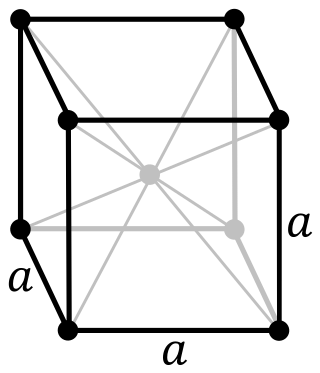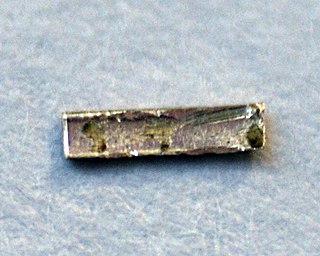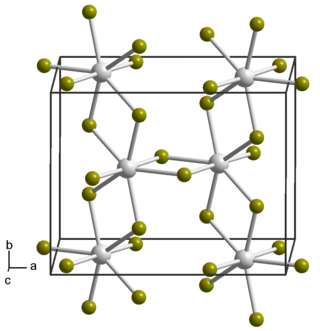Related Research Articles

Astatine is a chemical element; it has symbol At and atomic number 85. It is the rarest naturally occurring element in the Earth's crust, occurring only as the decay product of various heavier elements. All of astatine's isotopes are short-lived; the most stable is astatine-210, with a half-life of 8.1 hours. Consequently, a solid sample of the element has never been seen, because any macroscopic specimen would be immediately vaporized by the heat of its radioactivity.

Francium is a chemical element; it has symbol Fr and atomic number 87. It is extremely radioactive; its most stable isotope, francium-223, has a half-life of only 22 minutes. It is the second-most electropositive element, behind only caesium, and is the second rarest naturally occurring element. Francium's isotopes decay quickly into astatine, radium, and radon. The electronic structure of a francium atom is [Rn] 7s1; thus, the element is classed as an alkali metal.

Lutetium is a chemical element; it has symbol Lu and atomic number 71. It is a silvery white metal, which resists corrosion in dry air, but not in moist air. Lutetium is the last element in the lanthanide series, and it is traditionally counted among the rare earth elements; it can also be classified as the first element of the 6th-period transition metals.

Radium is a chemical element; it has symbol Ra and atomic number 88. It is the sixth element in group 2 of the periodic table, also known as the alkaline earth metals. Pure radium is silvery-white, but it readily reacts with nitrogen (rather than oxygen) upon exposure to air, forming a black surface layer of radium nitride (Ra3N2). All isotopes of radium are radioactive, the most stable isotope being radium-226 with a half-life of 1,600 years. When radium decays, it emits ionizing radiation as a by-product, which can excite fluorescent chemicals and cause radioluminescence.

The alkaline earth metals are six chemical elements in group 2 of the periodic table. They are beryllium (Be), magnesium (Mg), calcium (Ca), strontium (Sr), barium (Ba), and radium (Ra). The elements have very similar properties: they are all shiny, silvery-white, somewhat reactive metals at standard temperature and pressure.

Nonmetals are chemical elements that mostly lack distinctive metallic properties. They range from colorless gases like hydrogen to shiny crystals like iodine. Physically, they are usually lighter than metals; brittle or crumbly if solid; and often poor conductors of heat and electricity. Chemically, nonmetals have high electronegativity ; and their oxides tend to be acidic.
A period 7 element is one of the chemical elements in the seventh row of the periodic table of the chemical elements. The periodic table is laid out in rows to illustrate recurring (periodic) trends in the chemical behavior of the elements as their atomic number increases: a new row is begun when chemical behavior begins to repeat, meaning that elements with similar behavior fall into the same vertical columns. The seventh period contains 32 elements, tied for the most with period 6, beginning with francium and ending with oganesson, the heaviest element currently discovered. As a rule, period 7 elements fill their 7s shells first, then their 5f, 6d, and 7p shells in that order, but there are exceptions, such as uranium.

Nitrogen triiodide is an inorganic compound with the formula NI3. It is an extremely sensitive contact explosive: small quantities explode with a loud, sharp snap when touched even lightly, releasing a purple cloud of iodine vapor; it can even be detonated by alpha radiation. NI3 has a complex structural chemistry that is difficult to study because of the instability of the derivatives. Although nitrogen is more electronegative than iodine, the compound was so named due to its analogy to the compound nitrogen trichloride.

Tin(II) oxide is a compound with the formula SnO. It is composed of tin and oxygen where tin has the oxidation state of +2. There are two forms, a stable blue-black form and a metastable red form.

Barium bromide is the chemical compound with the formula BaBr2. It is ionic and hygroscopic in nature.
Thorium oxyfluoride is an inorganic compound of thorium metal, fluorine, and oxygen with the chemical formula ThOF
2.
Osmium(II) chloride or osmium dichloride is an inorganic compound composed of osmium metal and chlorine with the chemical formula OsCl
2.

Osmium octafluoride is an inorganic chemical compound of osmium metal and fluorine with the chemical formula OsF8. Some sources consider it to be a still hypothetical compound. An early report of the synthesis of OsF8 was much later shown to be a mistaken identification of OsF6. Theoretical analysis indicates OsF8 would have an approximately square antiprismatic molecular geometry.
Iridium(II) chloride is an inorganic chemical compound of iridium metal and chlorine with the chemical formula IrCl2. This is a metal salt of iridium and hydrochloric acid.
Osmium tetrasulfide is an inorganic compound, a salt of osmium metal and hydrogen sulfide acid with the chemical formula OsS4.
Radium oxide is an inorganic compound of radium and oxygen with the chemical formula RaO.
Radium tungstate is an inorganic compound of radium, oxygen, and tungsten with the chemical formula RaWO4. This is a salt of wolframic acid and radium.
Americium nitride is a binary inorganic compound of americium and nitride with the chemical formula AmN.

Indium monoiodide is a binary inorganic compound of indium metal and iodine with the chemical formula InI.

Neptunium tetrabromide is a binary inorganic compound of neptunium metal and bromine with the chemical formula NpBr4.
References
- ↑ Inorganic Chemistry. PHI Learning Pvt. Ltd. 2012. p. 186. ISBN 978-81-203-4308-5 . Retrieved 9 June 2023.
- ↑ Satya, Prakash (2013). Advanced Chemistry of Rare Elements. S. Chand Publishing. p. 216. ISBN 978-81-219-4254-6 . Retrieved 19 November 2023.
- ↑ R.D, Prakash Satya/ Tuli G. D. / Basu S. K. & Madan (2022). Advanced Inorganic Chemistry Volume I (LPSPE). S. Chand Publishing. p. 866. ISBN 978-93-5501-099-5 . Retrieved 9 June 2023.
- ↑ Satya, Prakash (2013). Advanced Chemistry of Rare Elements. S. Chand Publishing. p. 216. ISBN 978-81-219-4254-6 . Retrieved 9 June 2023.
- ↑ Бекман, Игорь (15 May 2022). Неорганическая химия. Радиоактивные элементы 2-е изд., испр. и доп. Учебник для СПО (in Russian). Litres. p. 98. ISBN 978-5-04-309059-1 . Retrieved 9 June 2023.